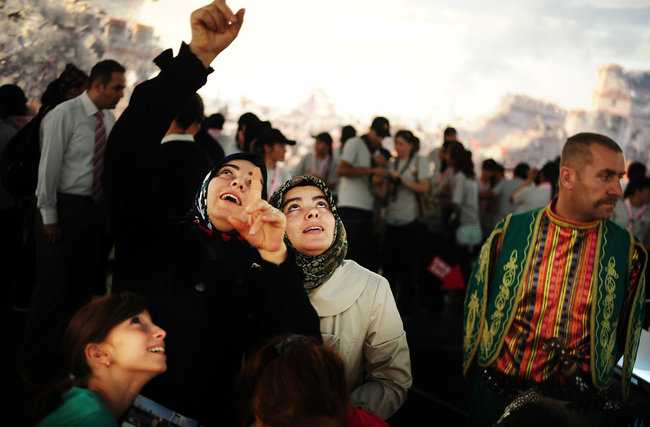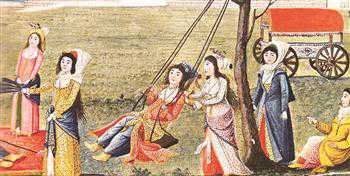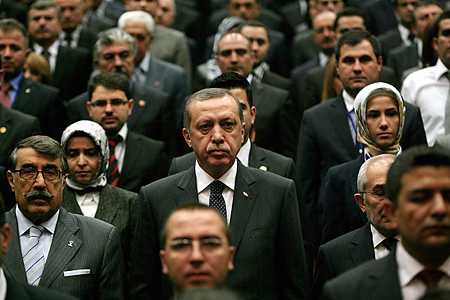“Conquest 1453” (known as “Fetih 1453” in Turkish) has spawned a television show with the same title and has encouraged clubs of proud Turks to re-enact battles from the empire’s glory days and even dress up as sultans and Ottoman nobles. The producers of “Once Upon a Time Ottoman Empire Mutiny,” a television series about the 18th-century insurrection against Sultan Ahmet Khan III, said they planned to build a theme park where visitors will be able to wander through a reproduction of Ottoman-era Istanbul and watch sword fights by stuntmen. At least four new films portray the battle of Gallipoli, the bloody World War I face-off between the Ottomans and Allied forces over the straits of Dardanelles and one of the greatest victories of modern Turkey. The coming “In Gallipoli” even includes Mel Gibson starring as a British commander.
The Ottoman period, particularly during the 16th and 17th centuries, was marked by geopolitical dominance and cultural prowess, during which the sultans claimed the spiritual leadership of the Muslim world, before the empire’s slow decline culminated in World War I. For years the period was underplayed in the history taught to schoolchildren, as the new Turkish Republic created by Mustafa Kemal Ataturk in 1923 sought to break with a decadent past.
Now, as Turkey is emerging as a leader in the Middle East, buoyed by strong economic growth, a new fascination with history is being reflected in everything from foreign policy to facial hair. In the arts, framed examples of Ottoman-era designs, known as Ebru and associated with the geometric Islamic motifs adorning mosques, have gained in popularity among the country’s growing Islamic bourgeoisie, adorning walls of homes and offices, jewelry and even business cards.
The three-year-old Panorama Museum, which showcases an imposing 360-degree, 45-foot-tall painting of the siege of Constantinople, complete with deafening cannon fire blasts and museum security guards dressed as Janissary soldiers, is drawing huge crowds.
And in the past few years there has been a proliferation of Ottoman-themed soap operas, none more popular than “The Magnificent Century,” a sort of “Sex in the City” set during the 46-year reign of Sultan Suleiman the Magnificent. The Turkish show pulpishly chronicles the intrigues of the imperial household and harem, including the rise of Suleiman’s slave girl-turned-queen, Hurrem. Last year it was broadcast in 32 countries, including Morocco and Kosovo.
The empire’s rehabilitation has inspired mixed feelings among cultural critics. “The Ottoman revival is good for the national ego and has captured the psyche of the country at this moment, when Turkey wants to be a great power,” said Melis Behlil, a film studies professor at Kadir Has University here. But, she warned: “It terrifies me because too much national ego is not a good thing. Films like ‘Conquest 1453’ are engaging in cultural revisionism and glorifying the past without looking at history in a critical way.”
Faruk Aksoy, the 48-year-old director of “Conquest 1453,” said that he had dreamed of making a film about the conquering of Istanbul ever since he arrived there at the age of 10 from Urfa, in Turkey’s rugged southeast, and had been mesmerized by Istanbul’s imperial grandeur. But he had to wait 10 years to make a big-budget film because the financing and technology were not available.
The film’s budget of $18.2 million was a record in Turkey, but it has more than recouped that, grossing $40 million in Turkey and Europe, Mr. Aksoy said. So stirred was a crowd at a recent screening that it roared “God is Great!” as the sword-wielding Ottomans scaled Istanbul’s forbidden walls. Mr. Aksoy recalled that one cinema manager debated calling the police, fearing a real fight.
“We Turks are hot-blooded people,” he said. “The Turks are proud about the conquest because it not only changed our history but it also changed the world.”
But others warn of a dangerous cultural jingoism at work. Burak Bekdil, a columnist for Hurriyet Daily News, mused in a recent column that the time was ripe for a film called “Conquest 1974,” to celebrate the Turkish invasion of Cyprus, or “Extinction 1915,” to commemorate the genocide of 1.5 million Armenians during World War I. Death threats followed.
Critics have also faulted the film for inaccuracies and hyperbole, though Mr. Aksoy stressed that he had employed Ottoman scholars. Members of the court of the last Byzantine emperor, Constantine XI — portrayed as hedonistic boozers surrounded by nubile dancing girls — talk in Turkish rather than Greek or Latin. Even Mehmet II, the conquering Sultan famed for his prodigious nose, has been retooled as a heroic pretty boy.
Alper Turgut, a leading film critic, deplored this one-dimensional universe even as he lauded the film’s epic ambitions. “If they had exaggerated just a bit more, it would be an absurdist comedy,” he said in an interview.
Mr. Aksoy expressed annoyance that a film meant to entertain was being politicized. “Would you ask Ridley Scott if he was politically influenced?” he asked.
Cultural critics noted that the film’s religious underpinning — there’s even a cameo by the Prophet Muhammad predicting that Constantinople will be conquered by believers — had made it popular with the growing Islamic bourgeoisie in a country that has increasingly turned its back on the crisis-ridden Europe and instead looks increasingly eastward. (The movie has also been embraced by some members of the governing Islamic party as an alternative to Hollywood’s “crusader mentality.”)
Religious conservatives had been marginalized during the secular cultural revolution undertaken by Ataturk. “For the first time we are seeing this new Islamic bourgeoisie, its tastes and its mores, reflected on the small and big screens,” Mr. Turgut said.
Ms. Behlil noted that the advent of big-budget television shows and films depicting the Ottoman era owed something to the country’s popularity in the Arab world, which was bringing in new revenues for production companies. Last year Turkey was Europe’s largest exporter of soap operas, pocketing $70 million in revenues.
But it is at home that the series and films are having a profound impact, educating a new generation of Turks.
Burak Temir, 24, a German-Turkish actor who played a prince on “Once Upon a Time Ottoman Empire Mutiny,” said he had initially been intimidated about portraying an era he knew so little about.
To prepare for his part, the show gave him a four-month crash course in Ottoman manners that included learning how to ride horses, sword fight, use a bow and arrow and puff out his chest. Even when not filming the show, he sports a Sultan-like beard and skinny Ottoman-style pants. “It makes me proud to be Turkish,” he said.








